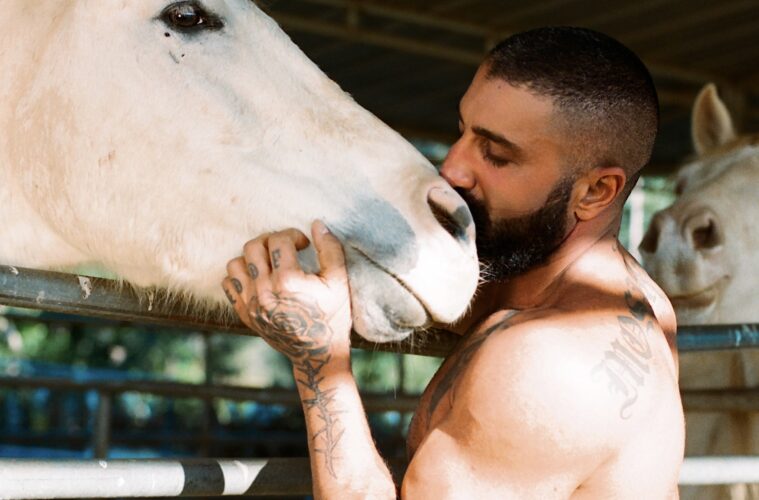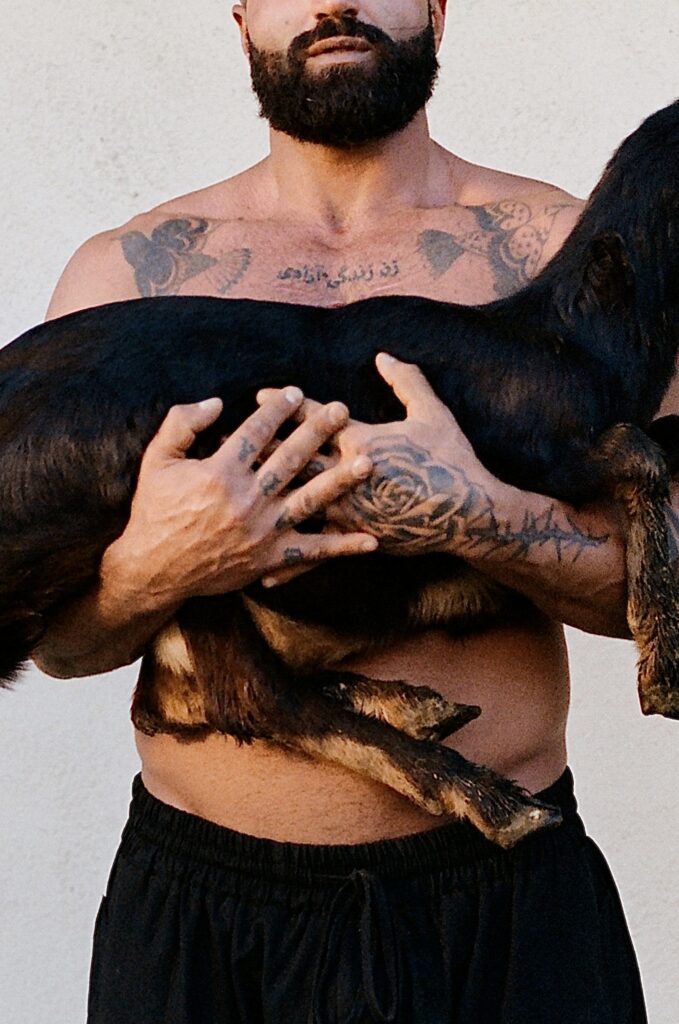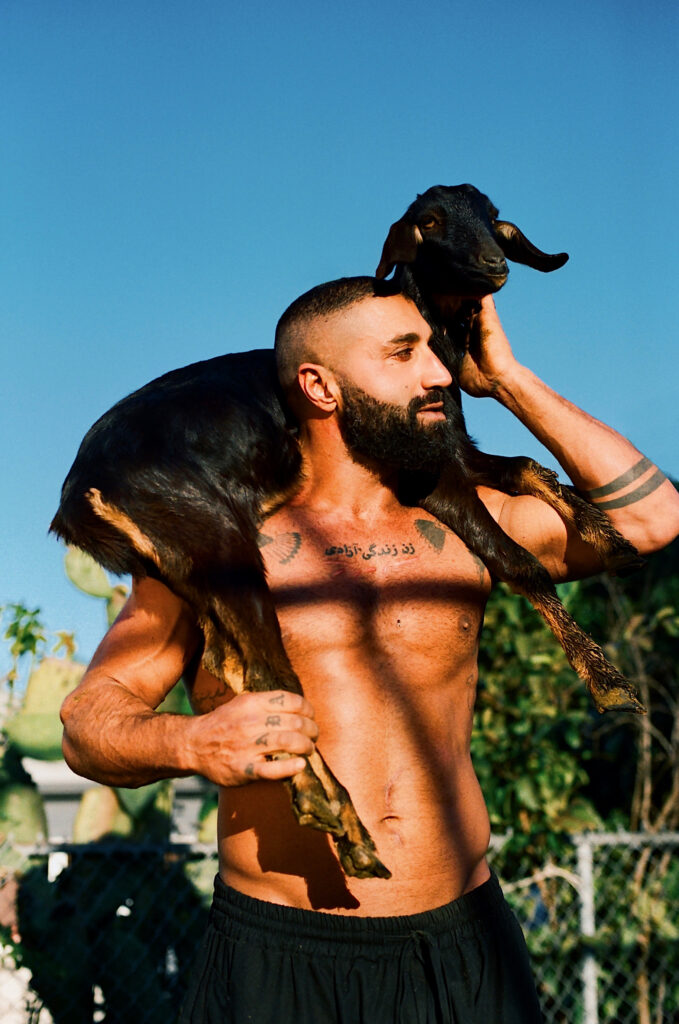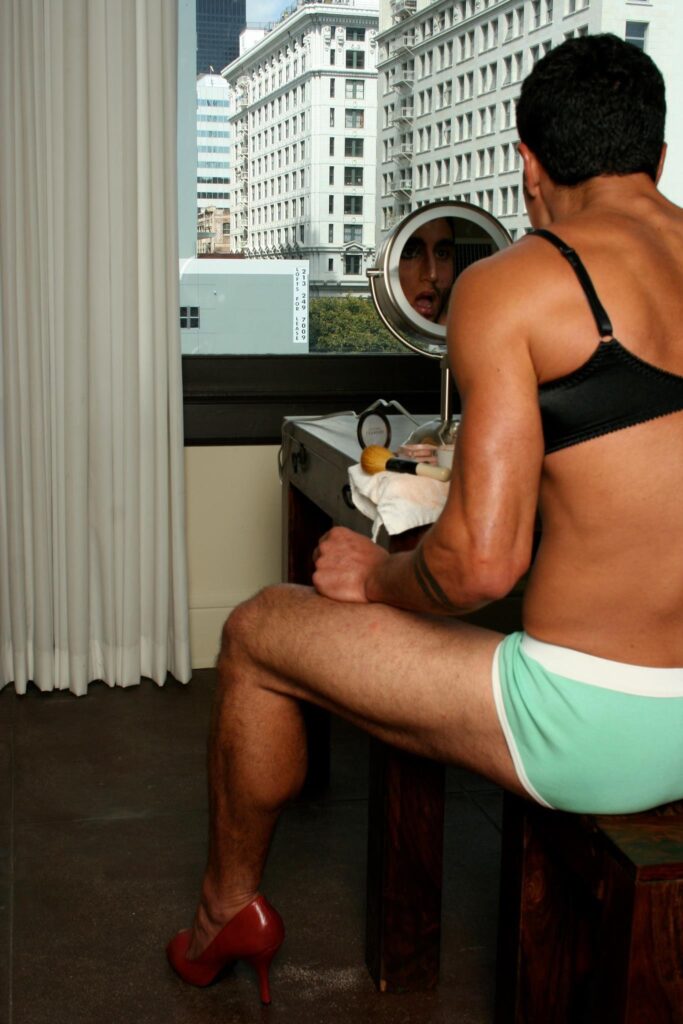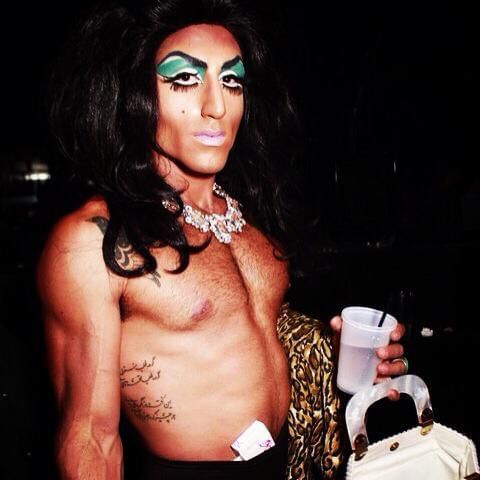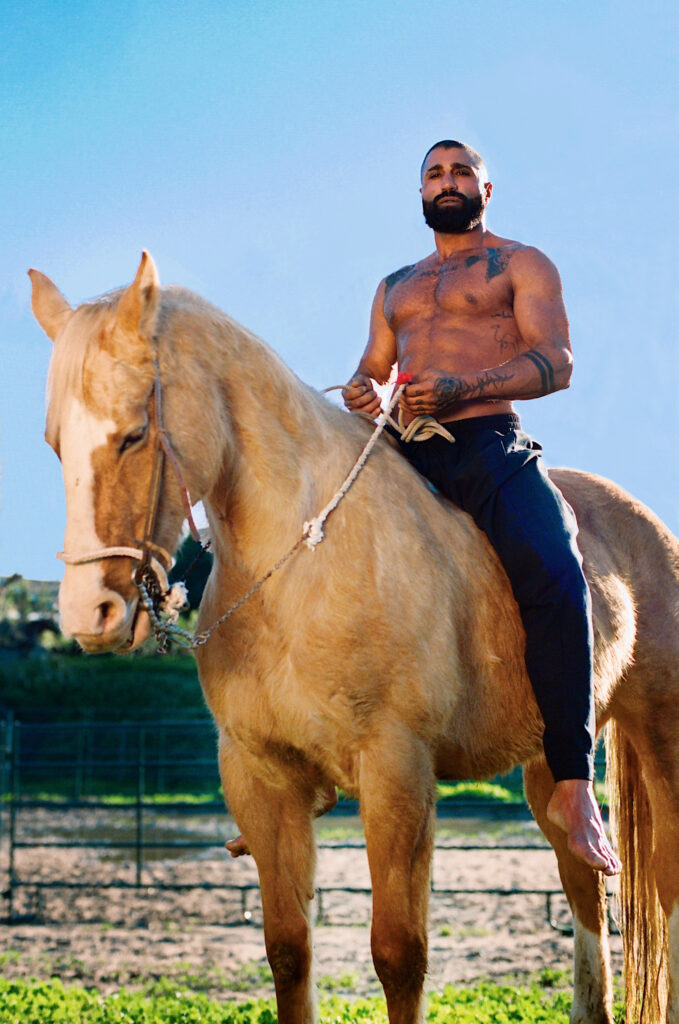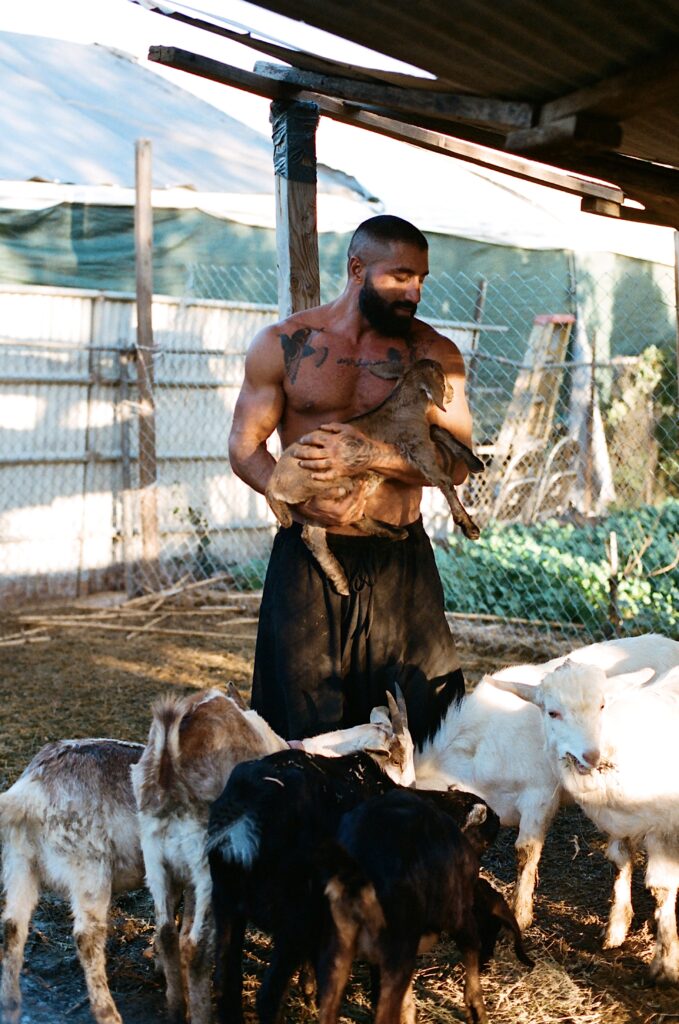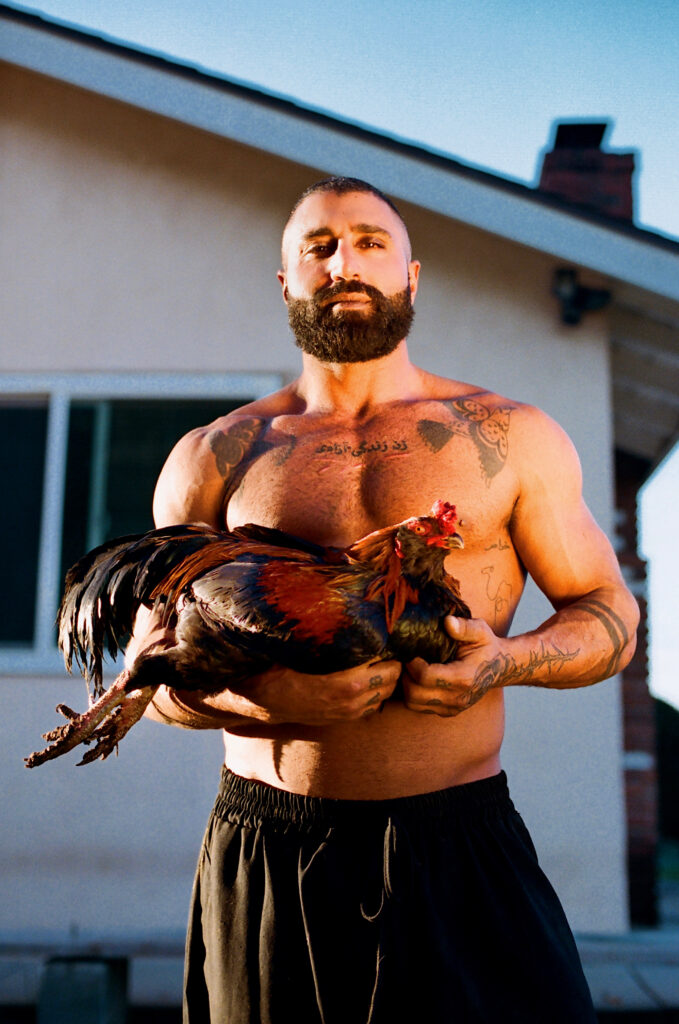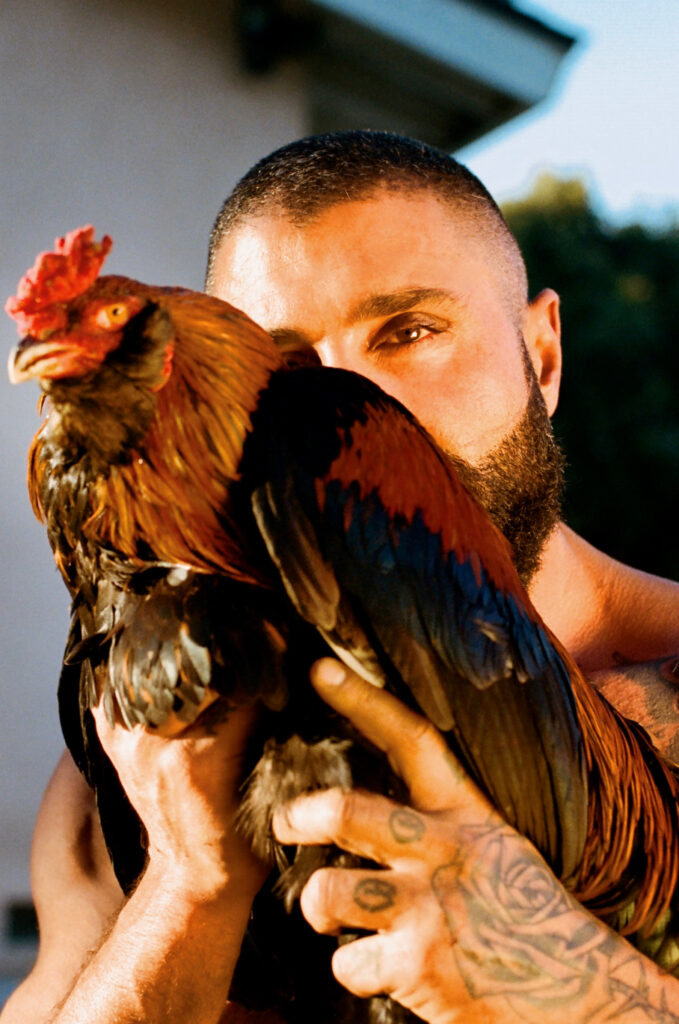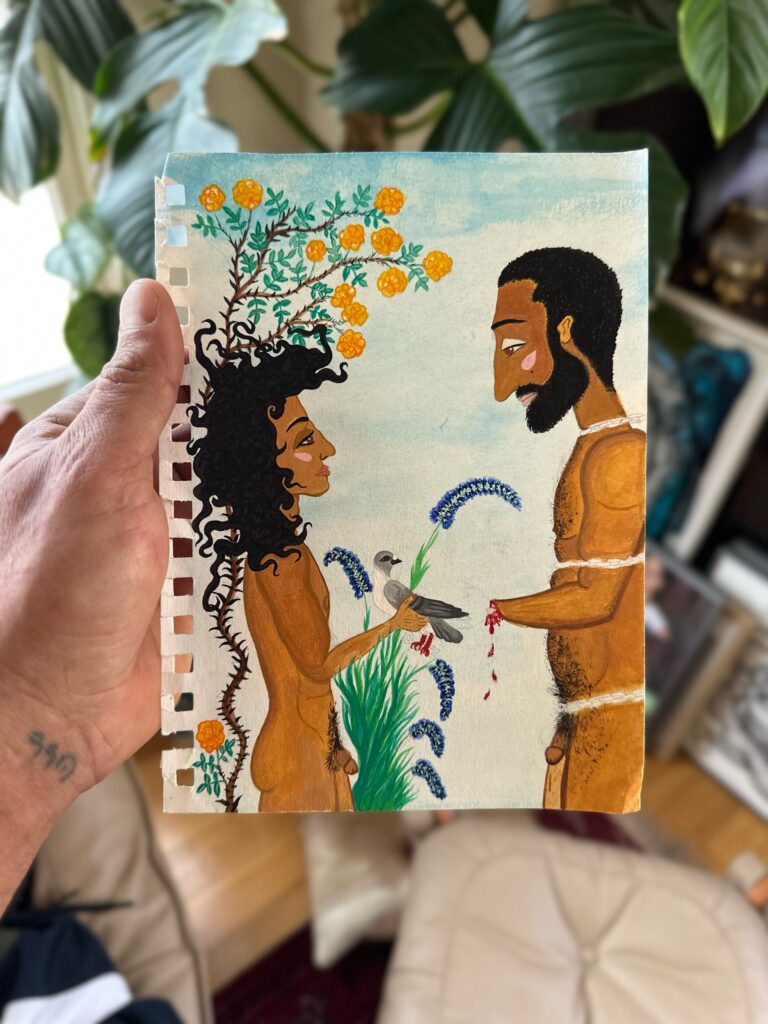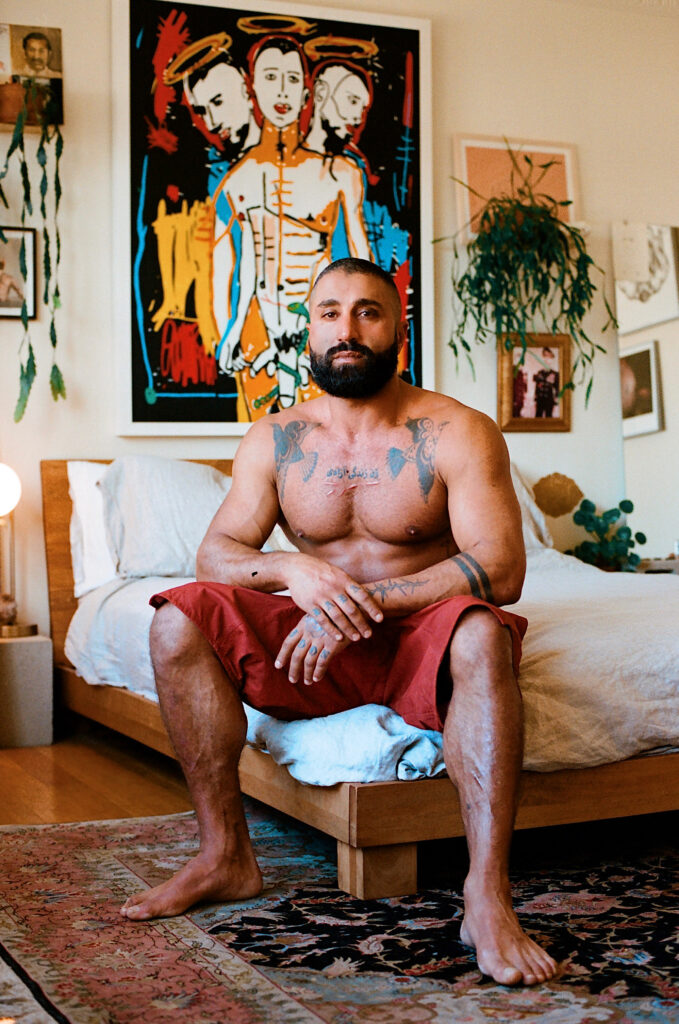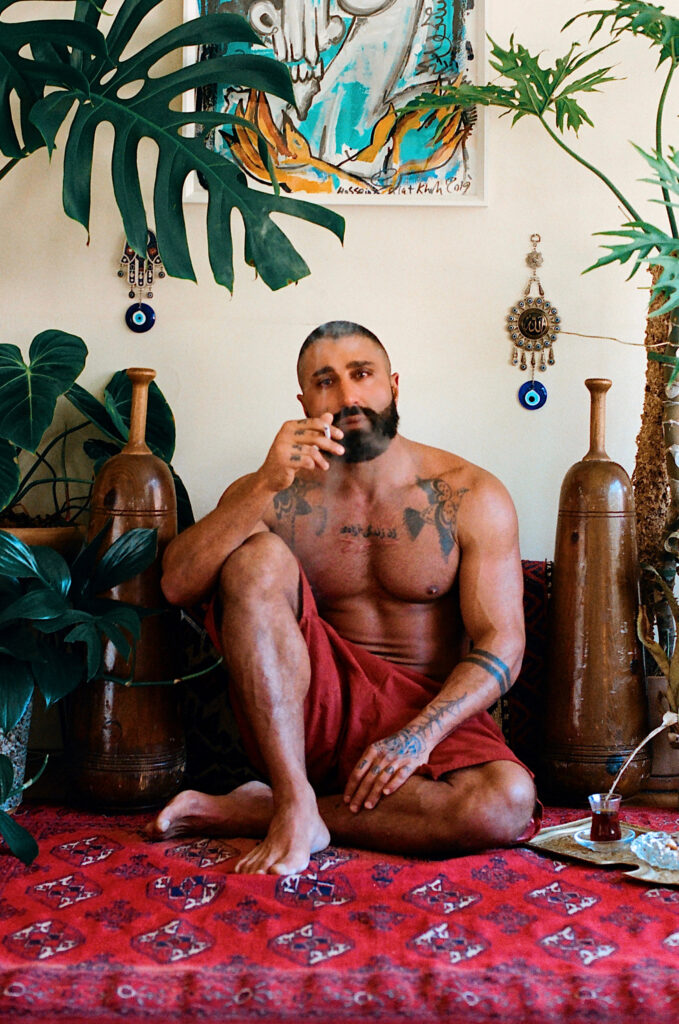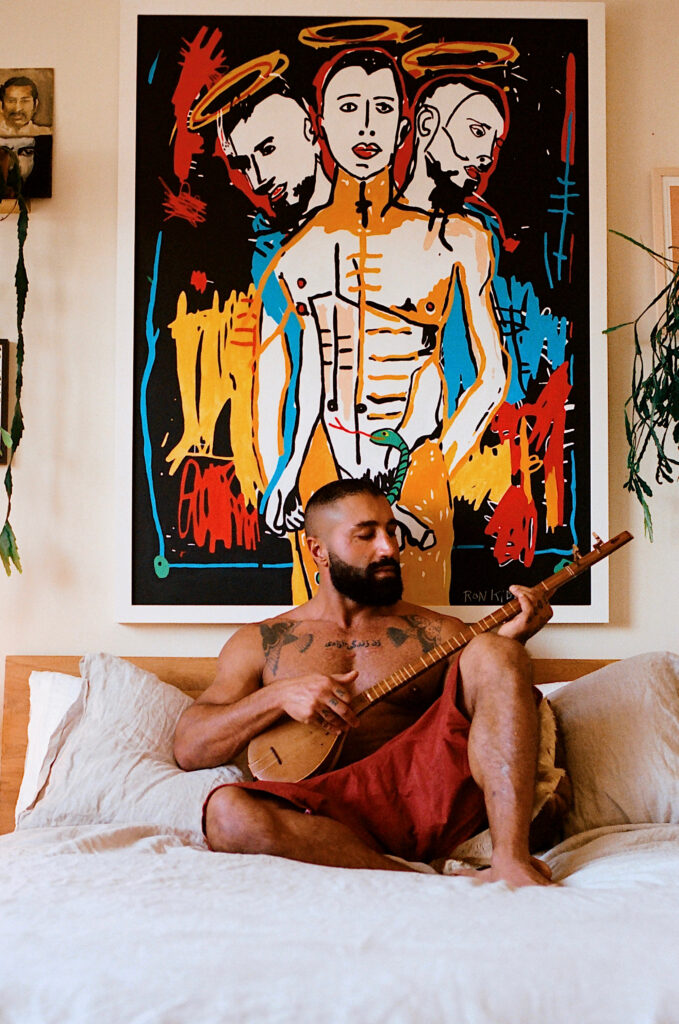Interview by Aryana Hessami
Photography by Roy Freiha
Creative direction by Sharok and Roy Freiha
Special thanks to Farm/animal shelter Tierra Caliente
Transcribed by Eliza Marks
This feature is part of the “The Wawa Complex” issue
Sharok (Sha) – a multi-talented master of painting and photography, a trained gardener, and an animal breeder – is most recognized for his work as a porn star and one of the first Iranian-American drag queens. Raised in a Persian household in LA, and conceived in the family restaurant, he knows that navigating a dual Iranian-American immigrant identity can be complicated. Throughout his career, he has sought to represent Iranians in the sex and fashion industries and used his popularity and social media, particularly his Instagram, to profile the voices of Iranians to the wider world.
As a British-Iranian, living in New York City, I was eager to speak with Sharok for My Kali, about how he navigates his identity, his role in his community, his childhood, his sexuality, his career, and his activism, and his hopes for the future. Our conversation is seeking intimate bonds across the diaspora community, fractures within it, and diaspora blues.
Photographed by Roy Freiha
Let’s talk about your childhood and formative years. What was it like growing up in a first-generation immigrant family vs your chosen community?
I grew up around so many Iranians and ethnic minorities, it didn’t feel like the States. Like many Iranians, my parents left Iran after the ‘79 revolution and settled in LA in the early ’80s. My parents and grandmother opened one of the first Persian restaurants in Hollywood (where I was conceived). I grew up in their restaurant surrounded by young, newly-to-the-US Iranian, Armenian, Mexican, and Central American expats, immigrants, and refugees; very immersed in Iranian culture. I’m lucky that I grew up with my father’s mother, she was the head chef. They called her Haji Khanoom, a devout Muslim woman, although moderate; she went to Mecca to perform hajj, I always wanted to go with her. She didn’t speak English, so Farsi was my first language. My grandfather was a pigeon breeder or “Kaftar Bazi” (Farsi), and he passed the tradition onto me. It doesn’t get more Irooni than that.
My parents got divorced when I was nine, so when having to choose between my dad’s abuse or my mom’s unstable household, I chose my friends. By 16 I was out and had a drug problem. My best friends growing up and their mothers took me in and allowed me to be whoever I wanted. They became my chosen family. They celebrated the fact that I was gay. My friends and I would party in West Hollywood, and their mums would always pick us up. I was young and out and I didn’t give a fuck. Like many queer youth, I didn’t have a plan, and I didn’t have guidance on how to navigate this new gay world. It was fun but scary sometimes; we’ve come a long way since then with effective treatments and PrEP, but back then AIDS was still a big fear. My mom’s first cousin, Aslan, died of AIDS when I was 15, so I thought that being gay meant AIDs and I didn’t have any plans for the future. I thought I would do whatever I wanted and that my time here was limited as a gay man, but here I am talking to you.
How did you get into sex work/pornography?
I dabbled in sex work as a minor in the bars and clubs in West Hollywood. At 18, I signed with an escort agency and did my first studio porn shoot. People gave me a lot of attention when I joined the gay scene; I used that to my advantage but, unfortunately, the gay porn scene wasn’t as accepting of non-white performers. I was used to being sexualized because I was “exotic” (there weren’t a lot of ‘out’ Iranian or SWANA guys back then) but when it came to selling DVDs, my look wasn’t what they wanted. It was a really white scene and “Middle Easterners” got lumped together. We understand our differences, but white people just judged us by our looks and didn’t know any better.
Image left: Sharok getting ready for Drag, 2010. Image on the right: Sharok in his drag alter-ego Mimi Mosavi, 2010. Images courtesy of Sharok.
Alongside adult performance, you spent time doing drag. What drew you to craft your drag character? How did you start developing this role?
I always loved drag and started doing it at 25. I didn’t really get along with the gay scene as a kid but I did get along with the drag performers and trans community. They took a motherly role because they really didn’t want anything sexual from me. It was a relief to go into a queer space as a drag queen and get a lot of attention but not be sexualized. Gay men were often turned off, or they thought it was weird to see a muscular guy dressed up, especially an Iranian one. I was one of the first Persian drag queens in LA.
Mimi Mosavi was my name at first, and then Tammie Brown started calling me ShaMimi (my middle name is Shamim and my nickname was Sham). Tammie Brown and Sparkle Stone taught me how to do my makeup. Juanita More was a big drag inspiration along with Dalida, my grandmother, and her sisters.
Have intimacy and pleasure been evidenced in any other sex-related work?
Sex work, yes. But Studio Porn has altered my sense of intimacy and pleasure. Studio porn in particular has little to do with intimacy or pleasure… it’s a job, it’s fantasy acting. It’s taking a private moment and creating the illusion of intimacy for millions of people to watch. The hard part is making it look real, but I’m good at my job. I have pleasure and intimate moments in my personal sex life and I cherish that.
The content that I produce myself for OnlyFans and other platforms shows a more intimate and real version of my sex life. I also have intimate relationships with people in a platonic sense; it’s not always about sex but about human connection for me.
Photographed by Roy Freiha
Being explicit about your identity as a queer Iranian porn star is important to you. What challenges have you faced in the sex industry as an openly queer Iranian?
Gay and queer role models are important to me. I didn’t have these when I was a kid. For a lot of people—especially from our part of the world— there is shame involved with sexuality. I have the privilege of living in a place where I can be who and what I am and I don’t take that for granted. I led with that because we didn’t have much queer representation from the diaspora. I knew gay family members and the guy I lost my virginity to (he was 62, not out but obviously gay, married with kids, but they lived in Iran… it was weird).
I wanted to be that person in the industry who I might have been searching for when I was younger but never found. With the introduction of fan sites (OnlyFans, JustFor.Fans, etc.), we have creative control over how we want to present ourselves and who we want to work with. When I started to gain momentum in the industry, I built a larger platform and wanted to represent my community and be able to reach more people with my activism and other interests.
I also wanted Iranians in Iran to be able to access my porn videos easily, so in 2017/18, I started sending videos directly through Instagram, WhatsApp, or Telegram to people who asked for them. I tried to get it out there for free through whatever channels. I developed relationships with Iranians in Iran this way and built a large fan base there and across the region. It opened up a new world for me, and it was fun to connect in that way.
Photographed by Roy Freiha
Did you see this work you were doing—developing lines of online access, curtailing internet censorship, and breaking down shame associated with sexuality—as a form of activism? How does it feel to be able to use your voice as a diaspora Iranian?
I try to use my voice as much as I can; it’s always been important to me. I’ve never met an Iranian who isn’t political. Our very existence in the diaspora is political. Even if I didn’t do sex work, the fact that I am a queer man of Iranian descent, or even that I’m here as the child of political refugees, makes me political. As I tell my Iranian friends who claim not to be political, we are political whether we want to be or not. Unfortunately, there isn’t a lot of support for queer voices in Iran; we have to try and fill that void.
I was modeling recently at Paris Fashion Week. I walked a show, and, without the designer’s approval, unbuttoned my shirt to point to my “Women, Life, Freedom” tattoo and held up a sign that said, “Stop Executions In Iran.” I wanted my walk to mean something, and the protest went viral.
It’s difficult to build spaces of support even from the diaspora because any talk about sexuality is immediately shut down. How can we begin the conversation about representation when the regime’s extreme dissonance denies the existence of queer people? Statements like Ahmadinejad’s, “There are no homosexuals in Iran” seem to deny the possibility of any identity position from which people can make political claims.
Ahmadinejad’s statement is especially funny because so many of these men and religious clerics have sex with men and boys but don’t consider themselves gay… It’s a stereotype but it’s real.
Social media is one of the only avenues we have right now to share stories and amplify voices that are otherwise being silenced in Iran. The Women, Life, Freedom movement would not have gained so much traction if it weren’t for social media. It’s a tool for everyone to get stories out and have their voices heard. I recently got this comment on my Instagram that, as an Iranian gay porn star, I’m doing more harm than good. For a second, I thought that they were maybe right, but then I realized that I am able to reach a completely different audience of followers than more “traditional” political accounts. That’s important.
Image on the Left: “This painting shows my current self chained to this sex worker life that I’ve created. The feminine figure on the left, with the pigeon and flowers, is also me; it’s the side of me that was a feminine, plant- and animal-loving, young person. That part of me is trying to hand the pigeon back to myself, but my hands are cut off.” Image on the Right: Sharok photographed by Roy Freiha in his apartment in L.A.
As someone who is openly queer, what do you think about a gendered movement, led by women, against gendered oppression in Iran?
The Women, Life, Freedom movement is fantastic. It’s a united front – women, men, queer, across ethnic/religious groups, across political and economic lines. It may have started as something about the hijab, but it snowballed into a critique of everything in Iran over the last 44 years, and even before. I know I would be imprisoned or put to death if I were there, but it doesn’t change the fact that I want to be able to go. I’m trying to do everything I can for my country from a distance.
There is this quote from Ijeoma Umebinyou’s “Diaspora Blues”: “So, here you are / Too foreign for home / Too foreign for here. / Never enough for both.” I feel like that sums up my experience, thus far. Being political is in our DNA and it’s the reason we are living outside of Iran. My mother gave up on going home, and I gave up a long time ago because there were attempts on the lives of family members, and then I started doing porn. And yet, this recent uprising has sparked a glimmer of hope that maybe there might be a chance for us to go back to Iran someday. I don’t see Iran ever returning to the way it was before my parents left, nor do I see the regime conceding. The majority may not support the protestors, but the country as a whole is sick and tired; the movement has already achieved enough of a shift that it cannot be ignored.
One shift (at least internationally) is showing that it isn’t Islam that’s the problem, but Human Rights and the regime’s interpretation of it. People are afraid to speak out against Islam, especially other people from the region. But it’s not about Islam; it’s about Human Rights and the regime’s interpretation of Islam that is the problem. The regime has scared a lot of people away from religion (my parents and myself included) and has ruined Islam for a lot of Iranians.
Photographed by Roy Freiha
What are you most proud of from last year and what does the future look like for you?
I’m just proud of the life that I’ve built. I just bought my first house, a dream that I never thought would be a reality, and have become one of the first Iranians to have such success in the industry. I’m looking to evolve in the coming years, but I don’t know what that really looks like. I’ve been working on more creative projects, getting back to painting and photography and I’m having fun with it. Plants and animals are a big part of my life so maybe I’ll find a way to incorporate all these aspects of myself into something new. Moving to Iran would be a long-term future goal for me too, buying land, raising pigeons again, and living out my older years surrounded by my people would be a dream. I’ll keep you updated.
On The Cover
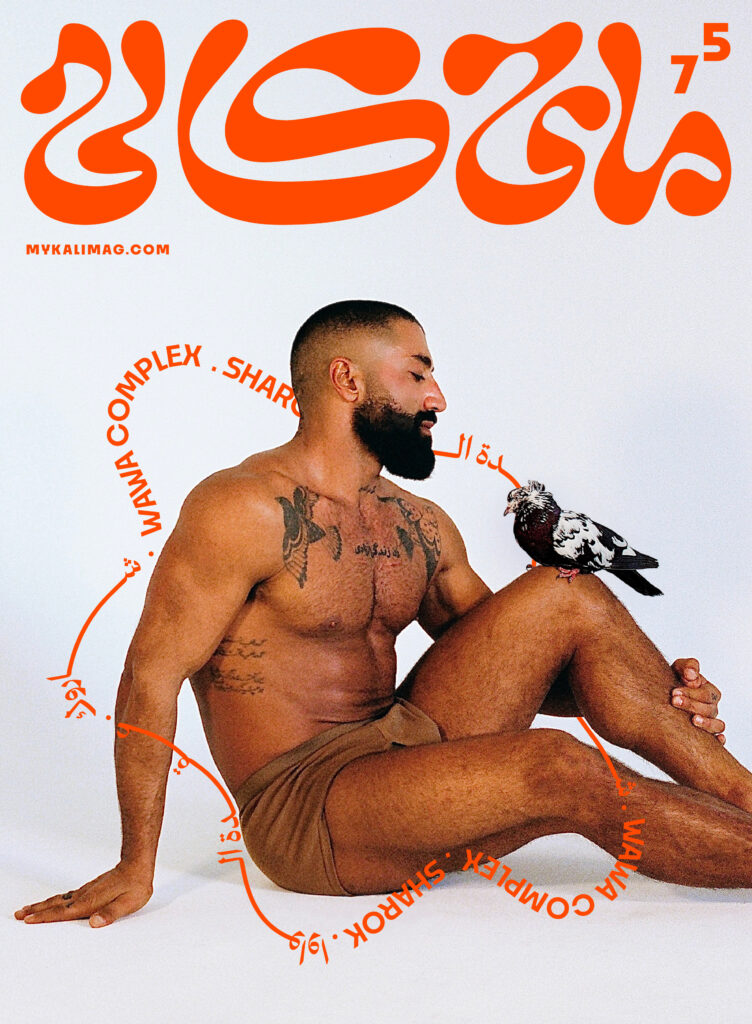
Photos and creative direction by Roy Freiha
Interview by Aryana Hessami
Cover design by Morcos Key
Cover design assembled by Alaa Sadi
Editor-in-Chief Khalid Abdel-Hadi
This feature is part of the “The Wawa Complex” issue

